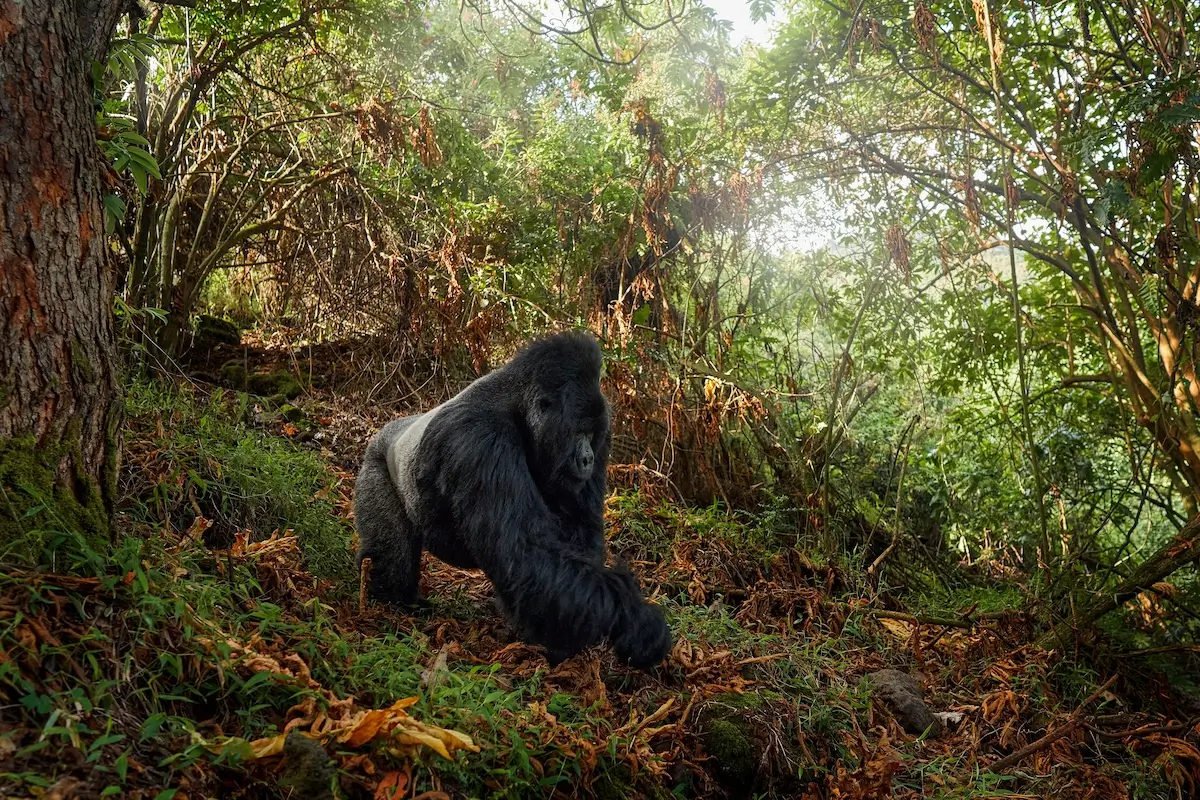
Experience a 15-day safari across Tanzania and Uganda, combining gorilla trekking, primate adventures, and wildlife safaris for a truly unique experience.
What to See:
Tarangire National Park: Known for its giant baobab trees and large elephant herds, Tarangire is a treasure trove of wildlife. The park is home to giraffes, zebras, lions, cheetahs, and leopards. Birdwatchers will delight in spotting over 500 species of birds. The Tarangire River becomes the focal point during the dry season, attracting a variety of wildlife.
Central Serengeti: Famous for its vast plains and abundant wildlife, Central Serengeti is the beating heart of the Serengeti ecosystem. Visitors can witness the Big Five—lion, leopard, buffalo, elephant, and rhino—along with cheetahs, giraffes, and an array of birdlife. It’s one of the best spots to observe predators in action and a perfect area for game drives year-round.
Ngorongoro Crater: A UNESCO World Heritage site, Ngorongoro Crater is a massive volcanic caldera filled with wildlife. This "Garden of Eden" hosts a variety of animals, including lions, elephants, rhinos, and flamingos. The crater’s high concentration of animals makes for incredible game-viewing opportunities.
Murchison Falls National Park: Murchison Falls, located on the Nile River, is one of Uganda’s most spectacular sites. The falls drop 43 meters, creating a thunderous roar. The park offers excellent game viewing with wildlife including elephants, giraffes, buffaloes, and lions. Boat cruises along the Nile are a highlight, offering views of the falls and abundant wildlife.
Ziwa Rhino Sanctuary: Located in Uganda, Ziwa Rhino Sanctuary is the only place in the country where rhinos can be seen in the wild. It offers a unique opportunity to see these magnificent creatures up close, as well as participate in rhino tracking excursions.
Kibale Forest National Park: Kibale is one of the best places in the world to track chimpanzees in the wild. Visitors can enjoy a guided chimpanzee trek, learning about these incredible primates and observing their social behaviors. The forest is also home to over 350 species of birds and other primates like red colobus and blue monkeys.
Queen Elizabeth National Park: Famous for its diverse landscapes and wildlife, Queen Elizabeth is a haven for animal lovers. Visitors can take boat cruises along the Kazinga Channel, where they’ll encounter hippos, crocodiles, and birds. The park is also home to lions, elephants, and tree-climbing leopards.
Bwindi Impenetrable National Park: The highlight of any primate trek, Bwindi is home to half of the world’s population of mountain gorillas. A gorilla trek through the thick, lush forest offers the chance to see these magnificent creatures up close. This UNESCO World Heritage site is one of the most thrilling wildlife experiences in Africa.
How to Dress on Safari:
- Neutral colors (khaki, brown, beige): Wear these to blend in with the environment and avoid attracting wildlife or insects.
- Comfortable, durable shoes: Suitable for walking through forests and on game drives.
- Long-sleeved shirts and trousers: To protect from sun exposure, insects, and thorny plants.
- Wide-brimmed hat: For sun protection.
- Sunscreen and sunglasses: To shield from UV rays.
- Light jacket or fleece: For early morning or evening game drives, which can be chilly.
- Rain gear: Especially in the green season (November - May), as you may encounter occasional rain.
What to Carry on Safari:
- Binoculars: For close-up views of wildlife.
- Camera with extra batteries and memory cards: To capture the stunning moments.
- Insect repellent: Essential to avoid bites, particularly in the forested areas like Kibale and Bwindi.
- Water bottle: Staying hydrated during game drives and hikes is crucial.
- Personal medications and a basic first aid kit: For emergencies.
- Small backpack: For carrying snacks, water, sunscreen, and other essentials during the day.
- Flashlight: For use at the campsite.
- Travel documents: Including passports, permits, and safari vouchers.
Best Time to Travel & Safari Seasons:
Dry Season (June - October):
- Best for game viewing: During the dry season, wildlife congregates around water sources, making it easier to spot animals.
- Great Wildebeest Migration: The migration season peaks between July and October, making it the best time to visit Serengeti for the migration spectacle.
- Ideal for gorilla trekking: Although it can be rainy in the higher altitudes, trekking in places like Bwindi and Kibale is still accessible.
Green Season (November - May):
- Quieter and more affordable: The parks are less crowded, and you can experience the natural beauty of lush landscapes.
- Gorilla trekking season: The green season is the calving season in many parks, including Serengeti, and also the best time for trekking in Uganda, as the forest is green and the gorillas are easier to spot.
- Ideal for birdwatching: The rainy season brings a surge of migratory birds to Uganda and Tanzania, making it an excellent period for birding enthusiasts.
Shoulder Seasons (April - May, and November):
- Less crowded and more affordable: These months fall between peak tourist seasons, offering a peaceful experience with fewer visitors and lower accommodation rates. However, be prepared for occasional rain showers.
Safari & Primate Trek Experience:
This 15-day adventure offers an immersive experience in some of the best wildlife destinations in East Africa. From game drives in iconic national parks to the thrilling primate treks in Uganda, you’ll discover the rich biodiversity of the region. Whether you're tracking gorillas through dense jungles or encountering the Big Five on a safari, each day will bring new and exciting encounters. With expert guides and the comfort of mobile camping and lodge accommodations, this safari provides the perfect blend of adventure and relaxation.
From Tanzania’s sprawling Serengeti to Uganda’s misty forests, this journey promises unforgettable memories of Africa’s most majestic creatures.